Inhibition of Quorum Sensing-Mediated Biofilm Formation and Spoilage Factors in Pseudomonas fluorescens by Plasma-Activated Water
Abstract
1. Introduction
2. Materials and Methods
2.1. Strains and Culture Preparation
2.2. PAW Generation Under Sub-Inhibitory Conditions
2.3. Enumeration of Bacterial Cells in Biofilm
2.4. Spoilage Factors Assay
2.5. AHLs Production Assay
2.6. AHLs Activity Assay
2.7. AHLs Structure Assay
2.8. Determination of Biofilm Formation with Exogenous C4-HSL
2.9. Determination of Spoilage Factors with Exogenous C4-HSL
2.10. Determination of Gene Expression with Exogenous C4-HSL
2.11. Molecular Docking
2.12. In Vivo Spoilage Potential of P. fluorescens in Fish Muscle Juice Assay
2.12.1. Fish Muscle Juice Contamination
2.12.2. TVC and pH Analysis
2.12.3. TBARS and TVB-N Analysis
2.12.4. AHLs Production Analysis
2.13. Statistical Analysis
3. Results and Discussion
3.1. The Effect of PAW on Biofilm Biomass
3.2. The Effect of PAW on Spoilage Factors
3.3. The Effect of PAW on AHLs Production of PF14
3.4. The Effect of PAW on AHLs Activity of PF14
3.5. The Effect of PAW on C4-HSL Structure
3.6. The Effect of Exogenous C4-HSL on the Biofilm Formation of PF14
3.7. The Effect of Exogenous C4-HSL on the Spoilage Factors of PF14
3.8. The Effect of Exogenous C4-HSL on the Gene Expression of PF14
3.9. Molecular Docking Analysis
3.10. The Effect of PAW on the Spoilage Potential of PF14 in Fish Muscle Juice
4. Conclusions
Author Contributions
Funding
Institutional Review Board Statement
Informed Consent Statement
Data Availability Statement
Conflicts of Interest
Abbreviation
| Abbreviation | Full term |
| PAW | Plasma-activated water |
| QS | Quorum sensing |
| QSI | Quorum sensing inhibitor |
| C4-HSL | N-butyryl-homoserine lactone |
| AHLs | Acyl homoserine lactones |
| AIPs | Autoinducing peptides |
| AI-2 | Autoinducer-2 |
| ACP | Acyl carrier protein |
| Quorum quenching | |
| SSO | Specific spoilage organism |
| TVC | Total viable count |
| TBARS | Thiobarbituric acid reactive substances |
| TVB-N | Total volatile basic nitrogen |
| CV026 | Chromobacterium violaceum 026 |
| TSB | Tryptic soy broth |
| CAS | Chrome azurol sulphonate |
| HPLC | High-performance liquid chromatography |
| ONPG | O-nitro-β-d-galactoside |
| TBA | Thiobarbituric acid |
| MDA | Malondialdehyde |
| DMSO | Dimethylsulfoxide |
| MICs | Minimum inhibitory concentrations |
| PALA | Plasma-activated lactic acid |
References
- Bassler, B.L. How bacteria talk to each other: Regulation of gene expression by quorum sensing. Curr. Opin. Microbiol. 1999, 2, 582–587. [Google Scholar] [CrossRef]
- Miller, M.B.; Bassler, B.L. Quorum sensing in bacteria. Annu. Rev. Microbiol. 2001, 55, 165–199. [Google Scholar] [CrossRef]
- Fuqua, C.; Greenberg, E.P. Listening in on bacteria: Acyl-homoserine lactone signalling. Nat. Rev. Mol. Cell Biol. 2002, 3, 685–695. [Google Scholar] [CrossRef] [PubMed]
- Gutierrez-Pacheco, M.M.; Bernal-Mercado, A.T.; Vazquez-Armenta, F.J.; González-Aguilar, G.; Lizardi-Mendoza, J.; Madera-Santana, T.; Nazzaro, F.; Ayala-Zavala, J. Quorum sensing interruption as a tool to control virulence of plant pathogenic bacteria. Physiol. Mol. Plant Pathol. 2019, 106, 281–291. [Google Scholar] [CrossRef]
- Wang, D.; Cui, F.; Ren, L.; Li, J.; Li, T. Quorum-quenching enzymes: Promising bioresources and their opportunities and challenges as alternative bacteriostatic agents in food industry. Compr. Rev. Food Sci. Food Saf. 2023, 22, 1104–1127. [Google Scholar] [CrossRef]
- Kalia, V.C. Quorum sensing inhibitors: An overview. Biotechnol. Adv. 2013, 31, 224–245. [Google Scholar] [CrossRef]
- Lin, L.; Zhang, P.; Chen, X.; Hu, W.; Abdel-Samie, M.A.; Li, C.; Cui, H. Inhibition of Staphylococcus aureus biofilms by poly-L-aspartic acid nanoparticles loaded with Litsea cubeba essential oil. Int. J. Biol. Macromol. 2023, 242, 124904. [Google Scholar] [CrossRef] [PubMed]
- Mohanty, D.; Suar, M.; Panda, S.K. Nanotechnological interventions in bacteriocin formulations–advances, and scope for challenging food spoilage bacteria and drug-resistant foodborne pathogens. Crit. Rev. Food Sci. Nutr. 2025, 65, 1126–1143. [Google Scholar] [CrossRef]
- Nayak, S.R.R.; Pohokar, P.; Das, A.; Dhivya, L.; Pasupuleti, M.; Soundharrajan, I.; Almutairi, B.O.; Kumaradoss, K.M.; Arockiaraj, J. Chalcone derivative enhance poultry meat preservation through quorum sensing inhibition against Salmonella (Salmonella enterica serovar Typhi) contamination. Food Control 2025, 171, 111155. [Google Scholar] [CrossRef]
- Ge, Z.; Du, X.; Liu, J.; Zhu, J.; Hao, H.; Bi, J.; Hou, H.; Zhang, G. Benzyl isothiocyanate suppresses biofilms and virulence factors as a quorum sensing inhibitor in Pseudomonas fluorescens. LWT 2024, 204, 116387. [Google Scholar] [CrossRef]
- Yin, L.; Zhang, Y.; Azi, F.; Zhou, J.; Liu, X.; Dai, Y.; Wang, Z.; Dong, M.; Xia, X. Inhibition of biofilm formation and quorum sensing by soy isoflavones in Pseudomonas aeruginosa. Food Control 2022, 133, 108629. [Google Scholar] [CrossRef]
- Alonso, V.P.P.; Furtado, M.M.; Iwase, C.H.T.; Brondi-Mendes, J.Z.; Nascimento, M.d.S. Microbial resistance to sanitizers in the food industry. Crit. Rev. Food Sci. Nutr. 2024, 64, 654–669. [Google Scholar] [CrossRef]
- Liu, L.; Li, J.; Tu, M.; Gao, L.; Zhang, Y.; Rao, Y.; Rao, L.; Gui, M. Complete genome sequence provides information on quorum sensing related spoilage and virulence of Aeromonas salmonicida GMT3 isolated from spoiled sturgeon. Food Res. Int. 2024, 196, 115039. [Google Scholar] [CrossRef]
- Chen, J.; Sun, Z.; Jin, J.; Wang, F.; Yang, Q.; Yu, H.; Yu, J.; Wang, Y. Role of siderophore in Pseudomonas fluorescens biofilm formation and spoilage potential function. Food Microbiol. 2023, 109, 104151. [Google Scholar] [CrossRef]
- Burger, M.; Woods, R.G.; McCarthy, C.; Beacham, I.R. Temperature regulation of protease in Pseudomonas fluorescens LS107d2 by an ECF sigma factor and a transmembrane activator. Microbiol.-Sgm 2000, 146, 3149–3155. [Google Scholar] [CrossRef] [PubMed]
- Yang, X.; Lan, W.; Sun, X. Effects of chlorogenic acid-grafted-chitosan on biofilms, oxidative stress, quorum sensing and c-di-GMP in Pseudomonas fluorescens. Int. J. Biol. Macromol. 2024, 273, 133029. [Google Scholar] [CrossRef] [PubMed]
- Wang, Y.; Wang, Y.; Chen, J.; Koseki, S.; Yang, Q.; Yu, H.; Fu, L. Screening and preservation application of quorum sensing inhibitors of Pseudomonas fluorescens and Shewanella baltica in seafood products. LWT 2021, 149, 111749. [Google Scholar] [CrossRef]
- Tang, R.; Zhu, J.; Feng, L.; Li, J.; Liu, X. Characterization of LuxI/LuxR and their regulation involved in biofilm formation and stress resistance in fish spoilers Pseudomonas fluorescens. Int. J. Food Microbiol. 2019, 297, 60–71. [Google Scholar] [CrossRef]
- Li, T.; Wang, D.; Liu, N.; Ma, Y.; Ding, T.; Mei, Y.; Li, J. Inhibition of quorum sensing-controlled virulence factors and biofilm formation in Pseudomonas fluorescens by cinnamaldehyde. Int. J. Food Microbiol. 2018, 269, 98–106. [Google Scholar] [CrossRef]
- Zhao, Y.-M.; de Alba, M.; Sun, D.-W.; Tiwari, B. Principles and recent applications of novel non-thermal processing technologies for the fish industry—A review. Crit. Rev. Food Sci. Nutr. 2019, 59, 728–742. [Google Scholar] [CrossRef]
- Zhao, Y.M.; Patange, A.; Sun, D.W.; Tiwari, B. Plasma-activated water: Physicochemical properties, microbial inactivation mechanisms, factors influencing antimicrobial effectiveness, and applications in the food industry. Compr. Rev. Food Sci. Food Saf. 2020, 19, 3951–3979. [Google Scholar] [CrossRef]
- Gao, R.; Zhang, X.; Cao, X.; Shi, T.; Wang, X.; Li, M.; Lu, C.; Liu, Y.; Tian, Y.; Jin, W.; et al. Plasma activated water (PAW)—gelatin coatings: Moderate oxidation of gelatin and controlled release of PAW for preservation of snakehead (Channa argus) fillets. LWT 2025, 228, 118103. [Google Scholar] [CrossRef]
- Wang, X.; Li, M.; Shi, T.; Xie, Y.; Jin, W.; Yuan, L.; Gao, R. Effect of plasma-activated water rinsing on the gelling properties of myofibrillar protein from Aristichthys nobilis surimi: Insights from molecular conformational transitions. Food Chem. 2025, 496, 146726. [Google Scholar] [CrossRef]
- Zhou, C.; Hu, Y.; Zhou, Y.; Yu, H.; Li, B.; Yang, W.; Zhai, X.; Wang, X.; Liu, J.; Wang, J.; et al. Air and argon cold plasma effects on lipolytic enzymes inactivation, physicochemical properties and volatile profiles of lightly-milled rice. Food Chem. 2024, 445, 138699. [Google Scholar] [CrossRef]
- Cui, H.; Li, H.; Abdel-Samie, M.A.; Surendhiran, D.; Lin, L. Anti-Listeria monocytogenes biofilm mechanism of cold nitrogen plasma. Innov. Food Sci. Emerg. Technol. 2021, 67, 102571. [Google Scholar] [CrossRef]
- Basiri, N.; Zarei, M.; Kargar, M.; Kafilzadeh, F. Effect of plasma-activated water on the biofilm-forming ability of Salmonella enterica serovar Enteritidis and expression of the related genes. Int. J. Food Microbiol. 2023, 406, 110419. [Google Scholar] [CrossRef]
- Lin, L.; Liao, X.; Li, C.; Abdel-Samie, M.A.; Cui, H. Inhibitory effect of cold nitrogen plasma on Salmonella Typhimurium biofilm and its application on poultry egg preservation. LWT 2020, 126, 109340. [Google Scholar] [CrossRef]
- Cai, Z.; Zhang, W.; Liao, G.; Huang, C.; Wang, J.; Zhang, J. Inhibiting mechanism of Pseudomonas aeruginosa biofilm formation-An innovational reagent of plasma-activated lactic acid. J. Water Process Eng. 2025, 69, 106613. [Google Scholar] [CrossRef]
- Li, Y.; Pan, J.; Wu, D.; Tian, Y.; Zhang, J.; Fang, J. Regulation of Enterococcus faecalis biofilm formation and quorum sensing related virulence factors with ultra-low dose reactive species produced by plasma activated water. Plasma Chem. Plasma Process. 2019, 39, 35–49. [Google Scholar] [CrossRef]
- Zhao, Y.-M.; Zhang, L.; Bao, Y.; Guo, Y.; Ma, H.; He, R.; Bourke, P.; Sun, D.-W. The inhibitory mechanisms of plasma-activated water on biofilm formation of Pseudomonas fluorescens by disrupting quorum sensing. Food Res. Int. 2025, 117436. [Google Scholar] [CrossRef]
- Li, P.; Mei, J.; Xie, J. Carbon dioxide can inhibit biofilms formation and cellular properties of Shewanella putrefaciens at both 30°C and 4 °C. Food Res. Int. 2022, 161, 111781. [Google Scholar] [CrossRef]
- Ding, T.; Li, T.; Wang, Z.; Li, J. Curcumin liposomes interfere with quorum sensing system of Aeromonas sobria and in silico analysis. Sci. Rep. 2017, 7, 8612. [Google Scholar] [CrossRef]
- Jahid, I.K.; Mizan, M.F.R.; Ha, A.J.; Ha, S.-D. Effect of salinity and incubation time of planktonic cells on biofilm formation, motility, exoprotease production, and quorum sensing of Aeromonas hydrophila. Food Microbiol. 2015, 49, 142–151. [Google Scholar] [CrossRef]
- Gui, M.; Wu, R.; Liu, L.; Wang, S.; Zhang, L.; Li, P. Effects of quorum quenching by AHL lactonase on AHLs, protease, motility and proteome patterns in Aeromonas veronii LP-11. Int. J. Food Microbiol. 2017, 252, 61–68. [Google Scholar] [CrossRef]
- Xu, C.; Ni, L.; Du, C.; Shi, J.; Ma, Y.; Li, S.; Li, Y. Decoding Microcystis aeruginosa quorum sensing through AHL-mediated transcriptomic molecular regulation mechanisms. Sci. Total Environ. 2024, 926, 172101. [Google Scholar] [CrossRef]
- Flynn, P.B.; Busetti, A.; Wielogorska, E.; Chevallier, O.P.; Elliott, C.T.; Laverty, G.; Gorman, S.P.; Graham, W.G.; Gilmore, B.F. Non-thermal plasma exposure rapidly attenuates bacterial AHL-dependent quorum sensing and virulence. Sci. Rep. 2016, 6, 26320. [Google Scholar] [CrossRef] [PubMed]
- Dalgaard, P. Qualitative and quantitative characterization of spoilage bacteria from packed fish. Int. J. Food Microbiol. 1995, 26, 319–333. [Google Scholar] [CrossRef] [PubMed]
- Liu, J.; Wang, Y.; Yang, P.; Li, H.; Mo, H.; Chisoro, P.; Han, D.; Zhang, C. Quality decline of prepared dishes stored at 4°C: Microbial regulation of nitrite and biogenic amine formation. Food Microbiol. 2025, 128, 104730. [Google Scholar] [CrossRef]
- Gan, J.; Mukaddas, M.; Tao, Y.; Liu, H.; Ye, K.; Zhou, G. High-voltage electrostatic field with 35 kV-15 min could reduce Pseudomonas spp. to maintain the quality of pork during− 1° C storage. Innov. Food Sci. Emerg. Technol. 2024, 94, 103700. [Google Scholar] [CrossRef]
- Li, T.; Sun, X.; Chen, H.; He, B.; Mei, Y.; Wang, D.; Li, J. Methyl anthranilate: A novel quorum sensing inhibitor and anti-biofilm agent against Aeromonas sobria. Food Microbiol. 2020, 86, 103356. [Google Scholar] [CrossRef]
- Zhao, Y.M.; Ojha, S.; Burgess, C.; Sun, D.W.; Tiwari, B. Inactivation efficacy and mechanisms of plasma activated water on bacteria in planktonic state. J. Appl. Microbiol. 2020, 129, 1248–1260. [Google Scholar] [CrossRef] [PubMed]
- Zhang, Y.; Kong, J.; Xie, Y.; Guo, Y.; Yu, H.; Cheng, Y.; Qian, H.; Shi, R.; Yao, W. Quorum-sensing inhibition by hexanal in biofilms formed by Erwinia carotovora and Pseudomonas fluorescens. LWT 2019, 109, 145–152. [Google Scholar] [CrossRef]
- Cui, F.; Wang, Q.; Liu, J.; Wang, D.; Li, J.; Li, T. Effects of deletion of siderophore biosynthesis gene in Pseudomonas fragi on quorum sensing and spoilage ability. Int. J. Food Microbiol. 2023, 396, 110196. [Google Scholar] [CrossRef] [PubMed]
- Machado, I.; Silva, L.R.; Giaouris, E.D.; Melo, L.F.; Simões, M. Quorum sensing in food spoilage and natural-based strategies for its inhibition. Food Res. Int. 2020, 127, 108754. [Google Scholar] [CrossRef]
- Lang, X.; Lan, W.; Liu, S.; Sun, X. Quorum sensing inhibitory of plant extracts on specific spoilage organisms and the potential utilization on the preservation of aquatic products. Chem. Eng. J. 2025, 506, 160259. [Google Scholar] [CrossRef]
- Li, T.T.; Cui, F.C.; Bai, F.L.; Zhao, G.H.; Li, J.R. Involvement of Acylated Homoserine Lactones (AHLs) of Aeromonas sobria in Spoilage of Refrigerated Turbot Scophthalmus maximus. Sensors 2016, 16, 1083. [Google Scholar] [CrossRef]
- Fidaleo, M.; Zuorro, A.; Lavecchia, R. Enhanced antibacterial and anti-quorum sensing activities of triclosan by complexation with modified β-cyclodextrins. World J. Microbiol. Biotechnol. 2013, 29, 1731–1736. [Google Scholar] [CrossRef]
- Zhang, Y.; Kong, J.; Huang, F.; Xie, Y.; Guo, Y.; Cheng, Y.; Qian, H.; Yao, W. Hexanal as a QS inhibitor of extracellular enzyme activity of Erwinia carotovora and Pseudomonas fluorescens and its application in vegetables. Food Chem. 2018, 255, 1–7. [Google Scholar] [CrossRef]
- Zhao, D.; Ding, Y.; Chen, W.; Hu, J.; Zhou, X. AHLs Based Quorum Sensing in Aeromonas veronii bv. veronii and Its Interruption from Garlic Extract. J. Chin. Inst. Food Sci. Technol. 2021, 21, 28–36. [Google Scholar] [CrossRef]
- Frey, R.L.; He, L.; Cui, Y.; Decho, A.W.; Kawaguchi, T.; Ferguson, P.L.; Ferry, J.L. Reaction of N-acylhomoserine lactones with hydroxyl radicals: Rates, products, and effects on signaling activity. Environ. Sci. Technol. 2010, 44, 7465–7469. [Google Scholar] [CrossRef]
- Shen, Y.; Cui, F.; Wang, D.; Li, T.; Li, J. Quorum quenching enzyme (pf-1240) capable to degrade ahls as a candidate for inhibiting quorum sensing in food spoilage bacterium Hafnia alvei. Foods 2021, 10, 2700. [Google Scholar] [CrossRef] [PubMed]
- Chowdhary, P.K.; Keshavan, N.; Nguyen, H.Q.; Peterson, J.A.; González, J.E.; Haines, D.C. Bacillus megaterium CYP102A1 oxidation of acyl homoserine lactones and acyl homoserines. Biochemistry 2007, 46, 14429–14437. [Google Scholar] [CrossRef] [PubMed]
- Zhang, Y.; Yu, H.; Xie, Y.; Guo, Y.; Cheng, Y.; Yao, W. Inhibitory effects of hexanal on acylated homoserine lactones (AHLs) production to disrupt biofilm formation and enzymes activity in Erwinia carotovora and Pseudomonas fluorescens. J. Food Sci. Technol. 2023, 60, 372–381. [Google Scholar] [CrossRef] [PubMed]
- Gao, X.; Gao, X.; Hua, Z.; Alhomrani, M.; Shi, C.; Lin, L.; Zhu, Y. Exploring inhibition of Listeria monocytogenes biofilm by carvacrol based on action to quorum sensing. Food Biosci. 2025, 63, 105790. [Google Scholar] [CrossRef]
- Yang, W.; Liu, S.; Liu, X.; Yuan, S.; An, L.; Ren, A.; Bai, F.; Lv, X.; Li, J.; Li, X. Novel quorum-sensing inhibitor peptide SF derived from Penaeus vannamei myosin inhibits biofilm formation and virulence factors in Vibrio parahaemolyticus. LWT 2025, 218, 117542. [Google Scholar] [CrossRef]
- Lu, L.; Hume, M.E.; Pillai, S.D. Autoinducer-2–like activity on vegetable produce and its potential involvement in bacterial biofilm formation on tomatoes. Foodbourne Pathog. Dis. 2005, 2, 242–249. [Google Scholar] [CrossRef]
- Chanioti, S.; Giannoglou, M.; Stergiou, P.; Passaras, D.; Dimitrakellis, P.; Kokkoris, G.; Gogolides, E.; Katsaros, G. Plasma-activated water for disinfection and quality retention of sea bream fillets: Kinetic evaluation and process optimization. Innov. Food Sci. Emerg. Technol. 2023, 85, 103334. [Google Scholar] [CrossRef]
- Liao, X.; Su, Y.; Liu, D.; Chen, S.; Hu, Y.; Ye, X.; Wang, J.; Ding, T. Application of atmospheric cold plasma-activated water (PAW) ice for preservation of shrimps (Metapenaeus ensis). Food Control 2018, 94, 307–314. [Google Scholar] [CrossRef]

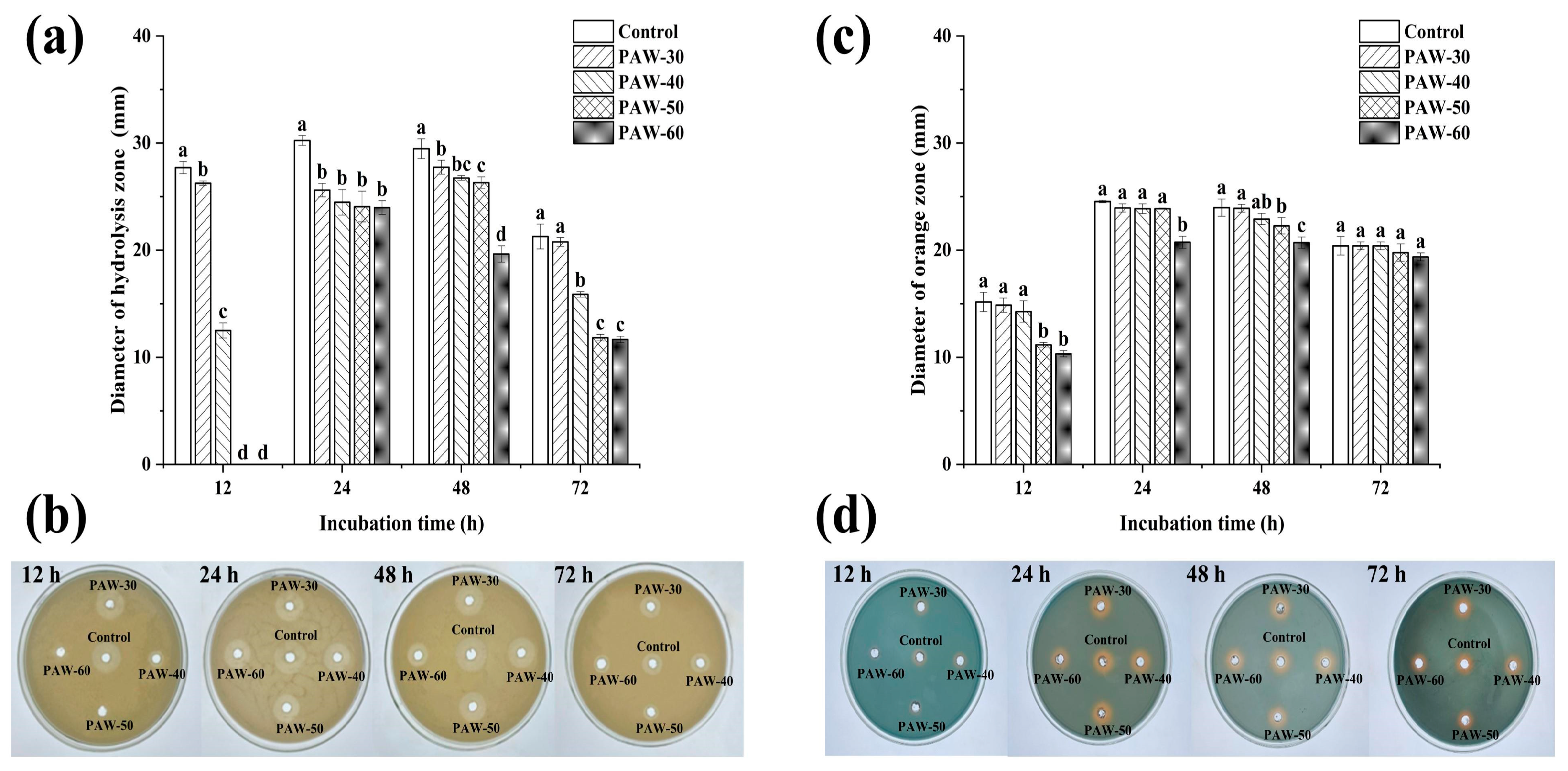

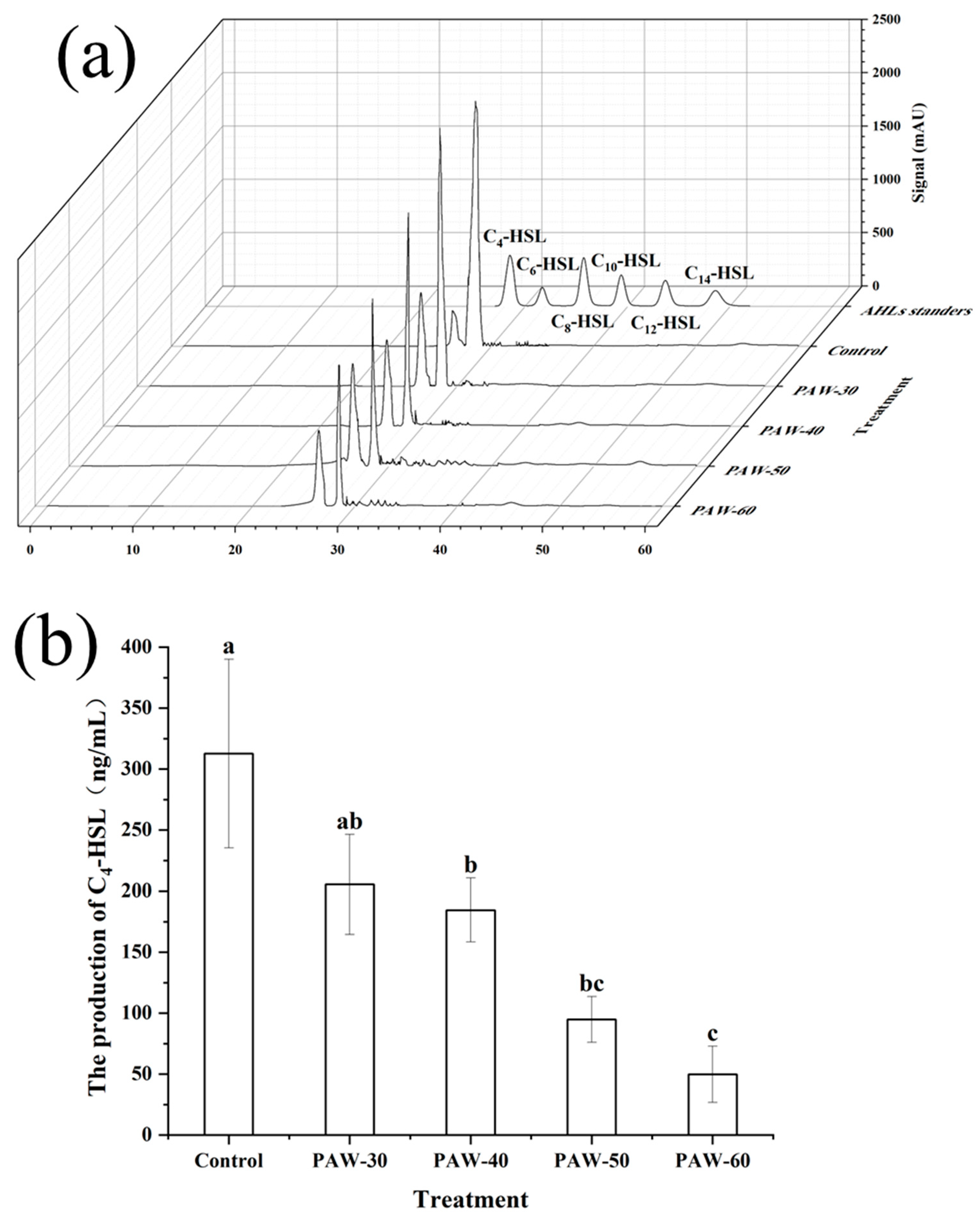
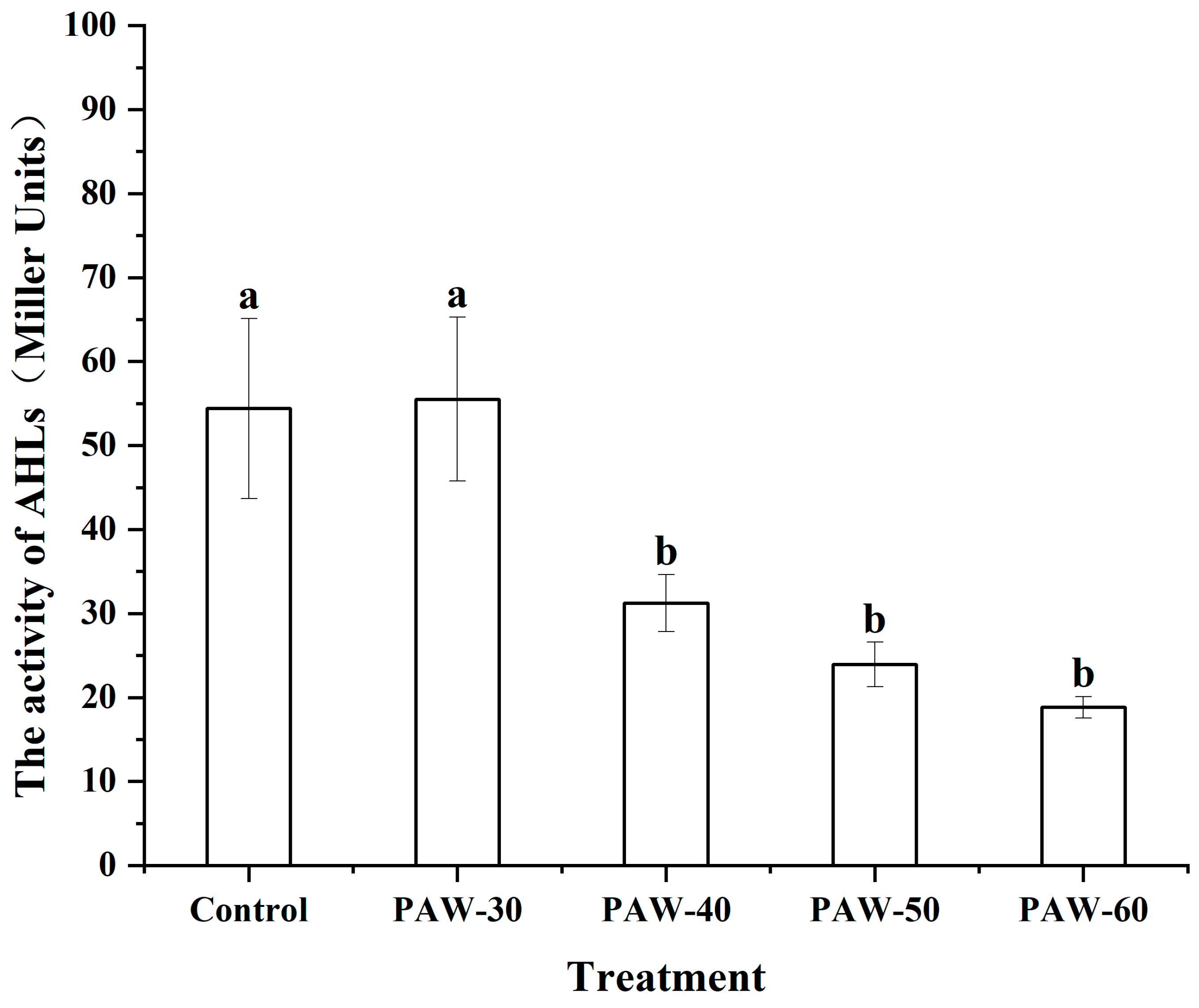
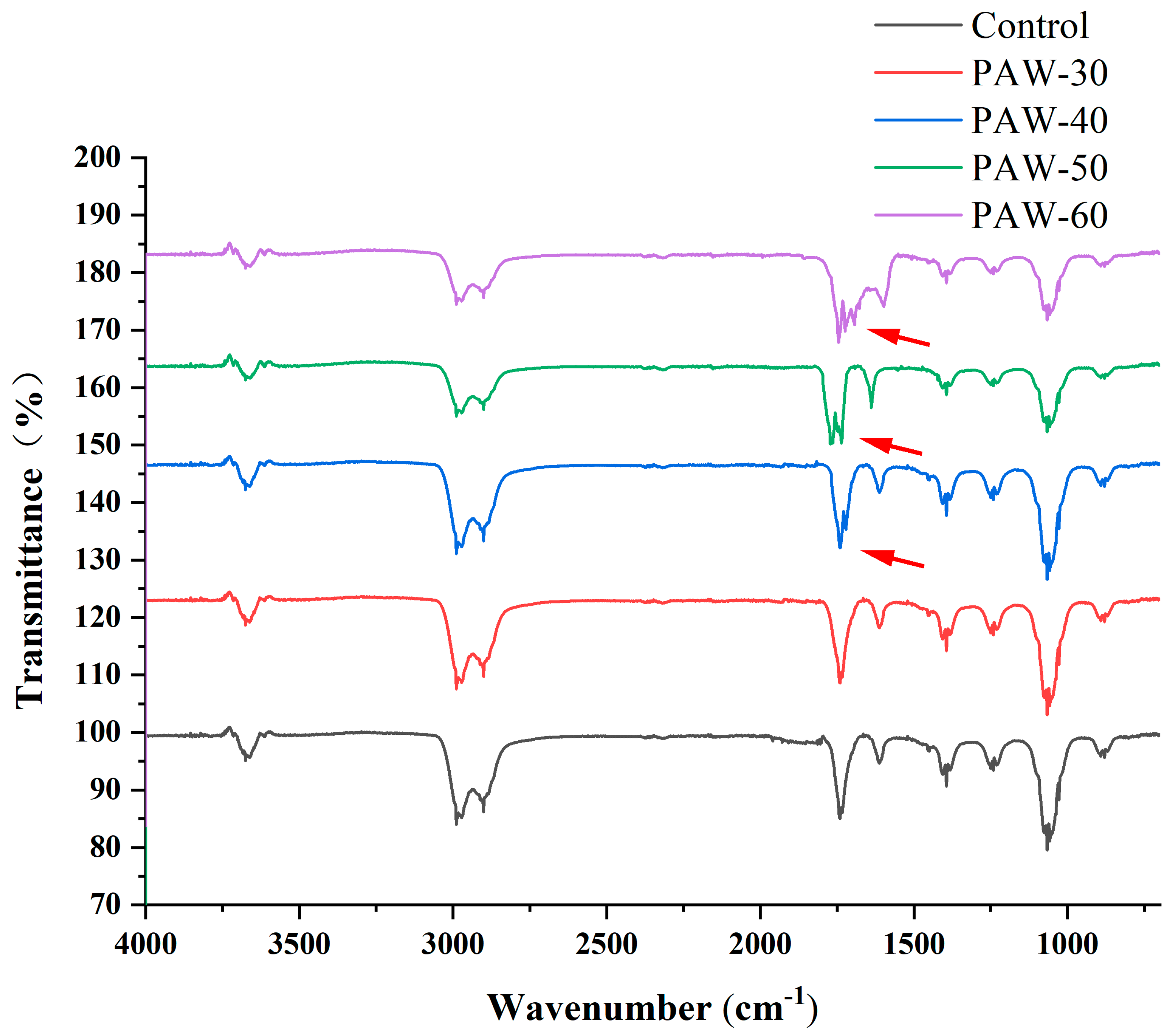


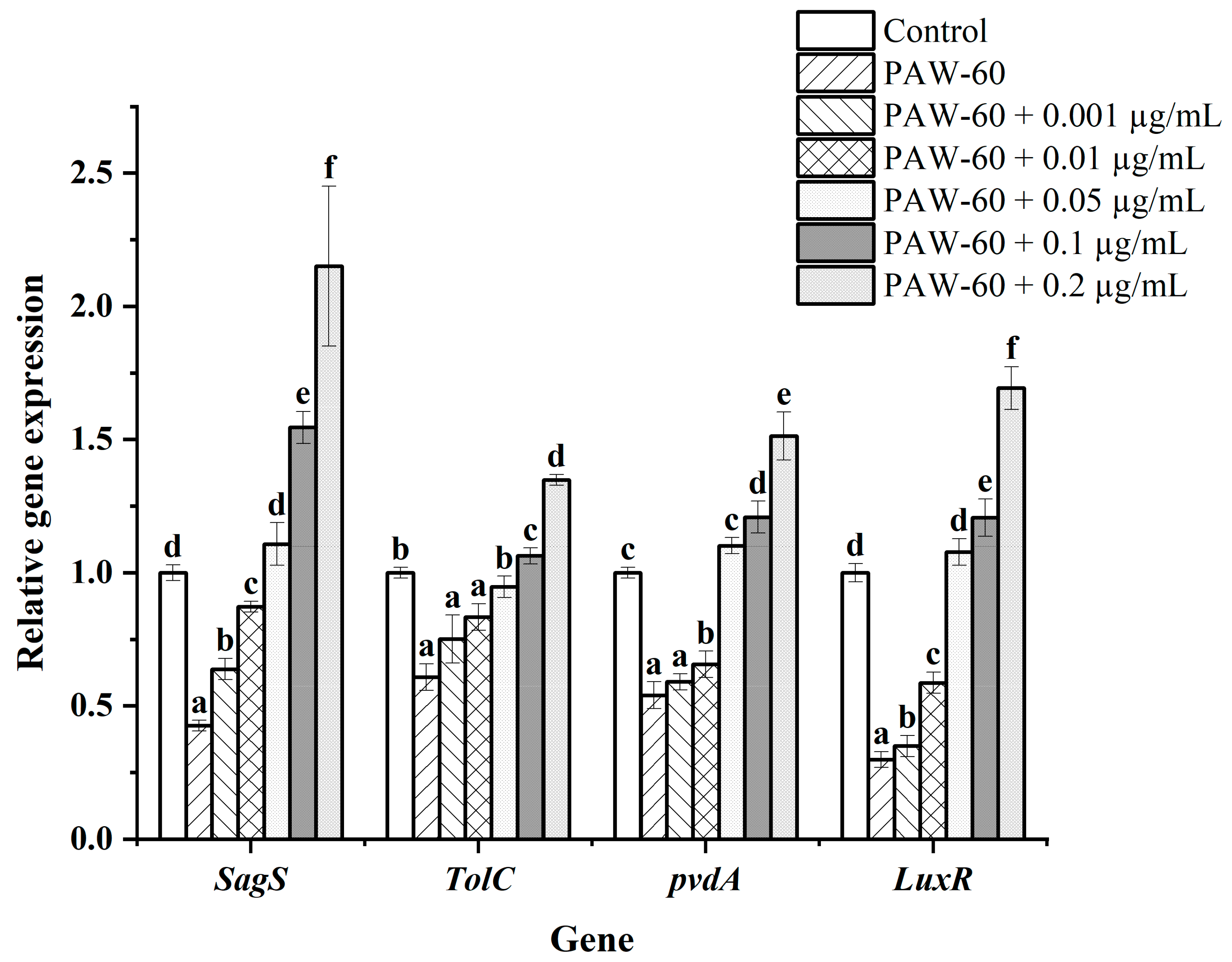
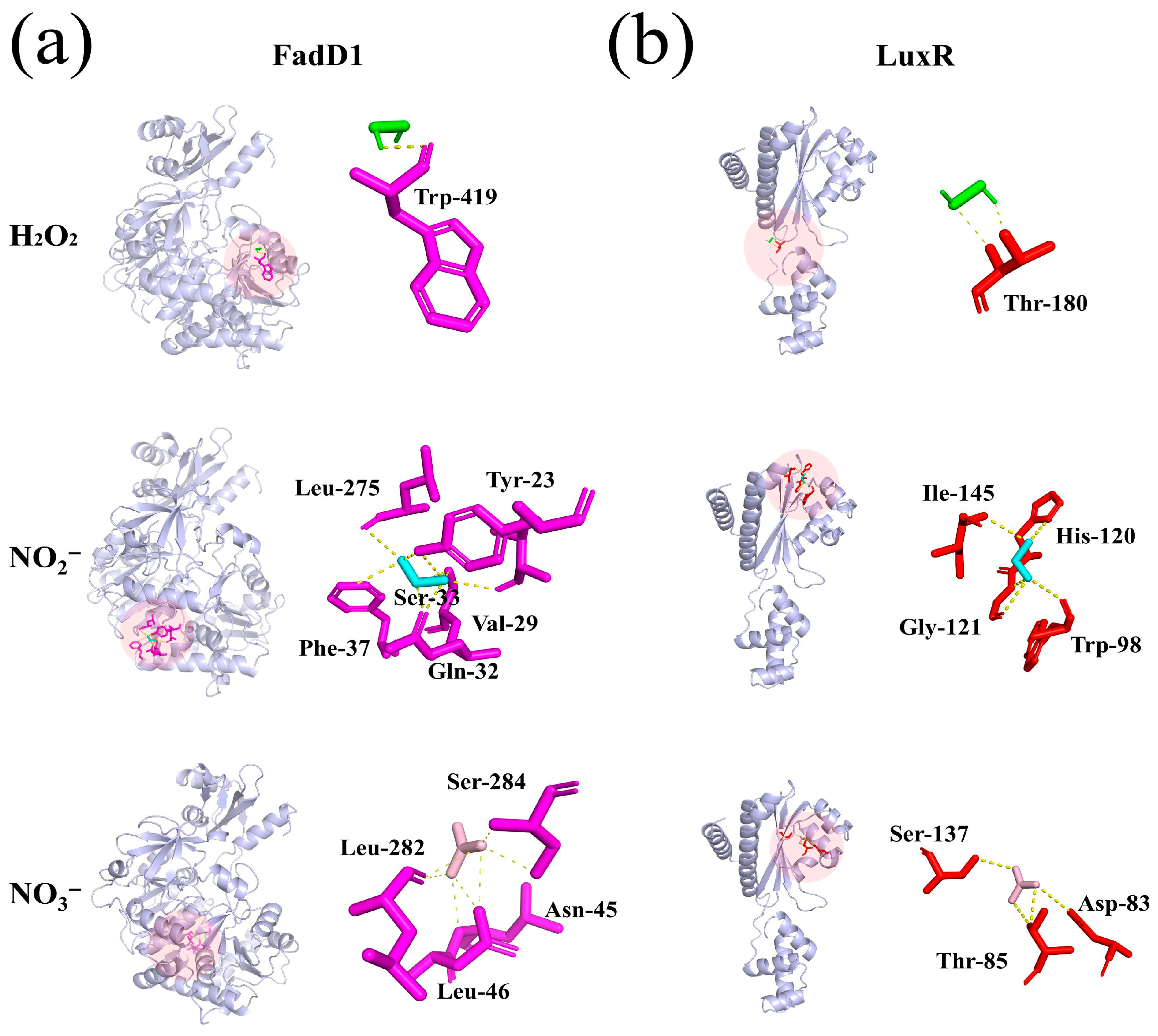
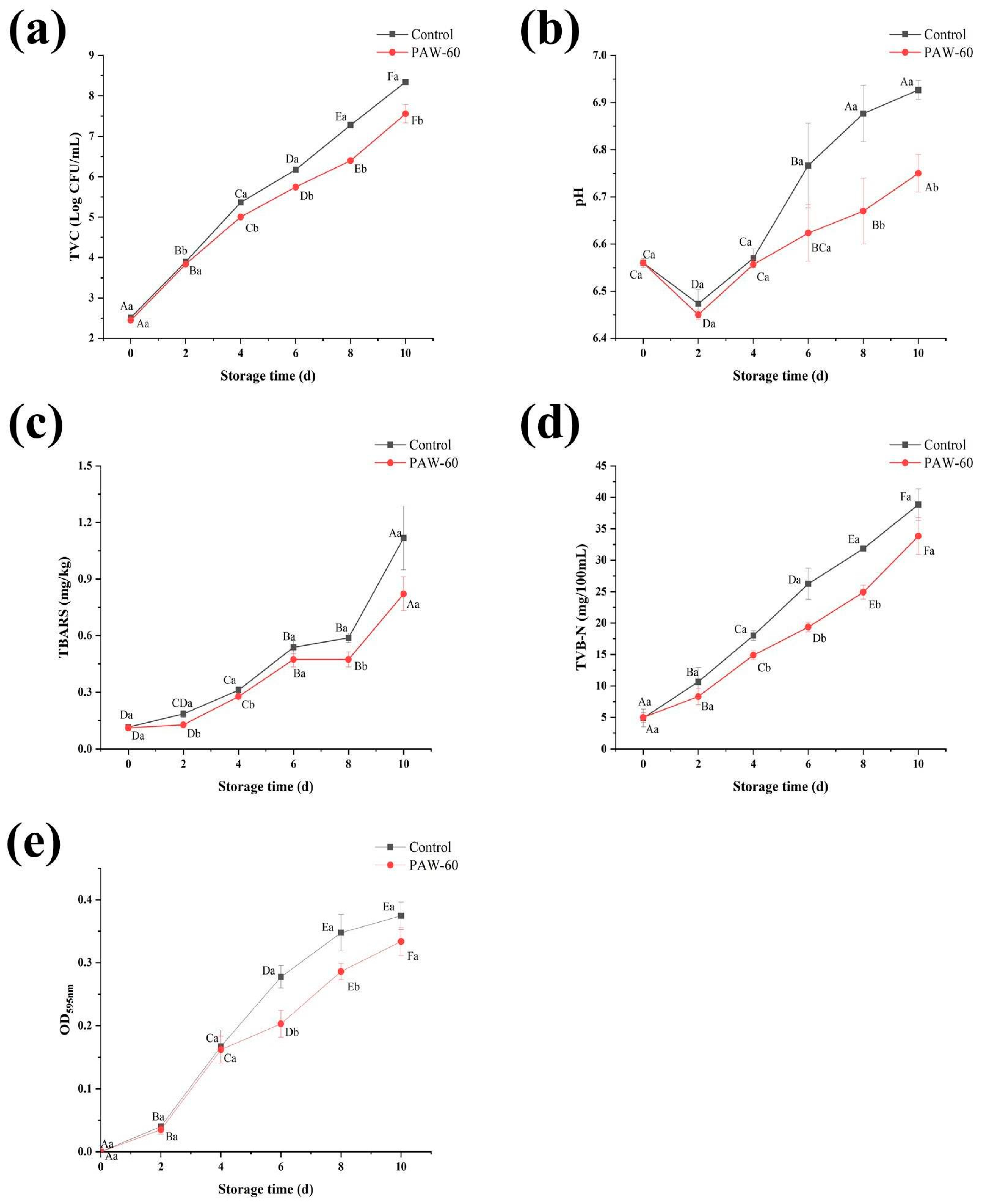

| Gene | Primer | Sequence (5′-3′) |
|---|---|---|
| 16S rRNA | 16S rRNA-F | GGAATCTGCCTGGTAGTGGG |
| 16S rRNA-R | CAGTTACGGATCGTCGCCTT | |
| SagS | sagS-F | GCTGAACTCGCTCAGGAACT |
| sagS-R | TGGCGCCAAACAGAAAATCG | |
| TolC | TolC-F | AACCGATTTGGTCAGCGTCT |
| TolC-R | CTTGTTCGTTGACGGCTTCG | |
| pvdA | pvdA-F | CCTGGTGACCCAGAGTGAAC |
| pvdA-R | GAGATCACACGCAACGCTTC | |
| LuxR | LuxR-F | GTGCCAACGCTATGCTGAAC |
| LuxR-R | TGCGATCCAAACAATGGCAC |
Disclaimer/Publisher’s Note: The statements, opinions and data contained in all publications are solely those of the individual author(s) and contributor(s) and not of MDPI and/or the editor(s). MDPI and/or the editor(s) disclaim responsibility for any injury to people or property resulting from any ideas, methods, instructions or products referred to in the content. |
© 2025 by the authors. Licensee MDPI, Basel, Switzerland. This article is an open access article distributed under the terms and conditions of the Creative Commons Attribution (CC BY) license (https://creativecommons.org/licenses/by/4.0/).
Share and Cite
Zhao, Y.-M.; Zhang, Q.-Y.; Zhang, L.; Bao, Y.-L.; Guo, Y.-T.; Huang, L.-R.; He, R.-H.; Ma, H.-L.; Sun, D.-W. Inhibition of Quorum Sensing-Mediated Biofilm Formation and Spoilage Factors in Pseudomonas fluorescens by Plasma-Activated Water. Foods 2025, 14, 3773. https://doi.org/10.3390/foods14213773
Zhao Y-M, Zhang Q-Y, Zhang L, Bao Y-L, Guo Y-T, Huang L-R, He R-H, Ma H-L, Sun D-W. Inhibition of Quorum Sensing-Mediated Biofilm Formation and Spoilage Factors in Pseudomonas fluorescens by Plasma-Activated Water. Foods. 2025; 14(21):3773. https://doi.org/10.3390/foods14213773
Chicago/Turabian StyleZhao, Yi-Ming, Qing-Yun Zhang, Lin Zhang, Yu-Long Bao, Yi-Ting Guo, Liu-Rong Huang, Rong-Hai He, Hai-Le Ma, and Da-Wen Sun. 2025. "Inhibition of Quorum Sensing-Mediated Biofilm Formation and Spoilage Factors in Pseudomonas fluorescens by Plasma-Activated Water" Foods 14, no. 21: 3773. https://doi.org/10.3390/foods14213773
APA StyleZhao, Y.-M., Zhang, Q.-Y., Zhang, L., Bao, Y.-L., Guo, Y.-T., Huang, L.-R., He, R.-H., Ma, H.-L., & Sun, D.-W. (2025). Inhibition of Quorum Sensing-Mediated Biofilm Formation and Spoilage Factors in Pseudomonas fluorescens by Plasma-Activated Water. Foods, 14(21), 3773. https://doi.org/10.3390/foods14213773







